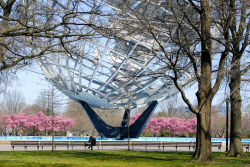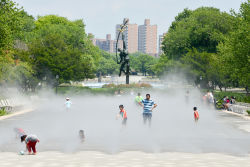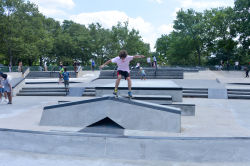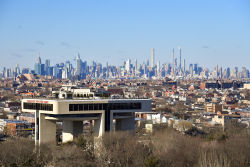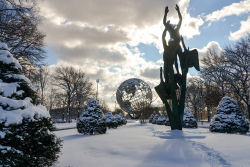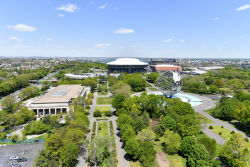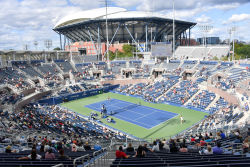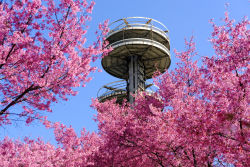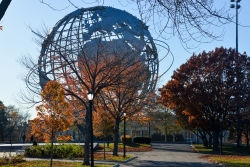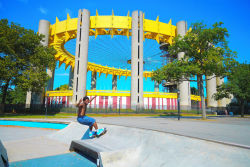Flushing Meadows Corona Park
The Daily Plant : Tuesday, March 3, 2009
Before They Were Parks (Part II)
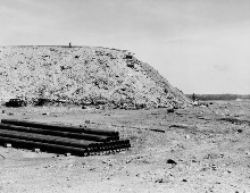
We continue our look at the history behind some of New York City’s most popular parks.
Pelham Bay Park
The city’s largest park, Pelham Bay Park also features a rich and varied history. Siwanoy Native Americans originally inhabited this area, followed by a short–lived English colony founded by Anne Hutchinson (for whom the nearby Hutchinson River is named) in what is now the northwest corner of this park.
Englishman Thomas Pell purchased 50,000 acres of land from the Siwanoy in 1654; during the Revolutionary War, Pell’s land was part of the buffer between the British–held Manhattan and rebel–held Westchester.
Robert Bartow purchased the land in 1836 and built the Bartow–Pell Mansion, which remained in the family until 1888 when the City acquired the estate. The mansion still sits on Shore Road.
In the 1930s, Parks Commissioner Robert Moses completed one of the most impressive public works projects by actually filling in the area between Hunter and Twin Islands in the Long Island Sound with three million cubic yards of landfill to craft Orchard Beach.
Silver Lake Park
The original Silver Lake (currently the south basin of the reservoir) was a spring-fed body of water formed at the end of the ice age. During the 19th century, a casino and saloon existed on the lakeshore and several companies harvested ice during the winter months for use in homes and businesses.
Once modern refrigeration made ice harvesting unnecessary, the lake was connected to the city water supply system, serving as the endpoint of the city’s Catskill water supply system from 1917 to 1971.
Just before the site became a City park, in February 1897, Silver Lake hosted the National Skating Amateur Championship races.
Mariner’s Marsh Park
The area around Mariner’s Marsh Park in Staten Island was once dominated by industrial development. The Milliken Brothers’ Structural Iron Works and Rolling Mill built its plant on the site of the park in 1903. Milliken Brothers was once one of the world’s largest manufacturers of steel products.
In 1917, the plant was converted to Downey’s Shipyard, which, needless to say, was bustling with activity as a result of World War I.
The park’s ten ponds are actually remnants of the site’s shipbuilding past: a system to get ships to the nearby Kill Van Kull necessitated exposing the area’s water table. The basins created to solve this problem became the ponds we see today.
Newtown Playground
As early as 1730, the land now comprising Newtown Playground was used as a cemetery. Some of Newtown's most prominent residents were buried here, including members of the Moore and Fish families, successful fruit growers and farmers.
The land was transferred to the Department of Parks in 1917. The 1927-28 Queens Annual Report noted that “[a]ll the old headstones, which stuck up like eyesores, were laid flat and covered with soil.” The park was fully developed as a playground in 1934–35.
Flushing Meadows-Corona Park
The former dumping ground labeled a “valley of ashes” by F. Scott Fitzgerald in The Great Gatsby went on to become Queens’ largest park.
The swampy area was first converted into a 1,200–acre fairground for the 1939–40 World’s Fair. For a five–year span between 1946 and 1950, while its permanent home was being built on the east side of Manhattan, the first United Nations assembled within the park.
QUOTATION FOR THE DAY
“A finished person is a boring person.”
Anna Quindlen
(1953 - )
Check out your park's Vital Signs
Clean & Safe
Green & Resilient
Empowered & Engaged Users
Share your feedback or learn more about how this park is part of a
Vital Park System

Know Before You Go

Downloads
- New York State Pavilion Listening Session
- Strategic Framework Plan: Introduction
- Strategic Framework Plan: Site Analysis
- Strategic Framework Plan: Conceptual Framework, Part I
- Strategic Framework Plan: Conceptual Framework, Part II
- Strategic Framework Plan: Vision and Goals, Part I
- Strategic Framework Plan: Vision and Goals, Part II
- Strategic Framework Plan: Appendix, Part I
- Strategic Framework Plan: Appendix, Part II
Links
- National Tennis Center Strategic Vision Project
- World Ice Arena
- Citi Field
- Mets Ticketing
- USTA National Tennis Center
- US Open
- Terrace on the Park Catering Hall
- New York Hall of Science
- Queens Museum
- Queens Botanical Garden
- Queens Theatre
- Queens Wildlife Conservation Center
- Fantasy Forest at the Flushing Meadows Carousel
- Wheel Fun Rentals
- Alliance for Flushing Meadows Corona Park
Contacts
General Park Info: (718) 760-6565
Pitch N Putt Golf and Miniature Golf : (718) 271-8182
World's Fair Marina on Flushing Bay : (718) 478-0480
World's Fair Marina Restaurant: (718) 898-1200
Terrace on the Park: (718) 592-5000
Citi Field: (718) 699-4220
Mets Ticketing: (718) 507-TIXX
USTA National Tennis Center: (718) 760-6200
US Open/USTA: (914) 696-7000
New York Hall of Science: (718) 699-0005
Queens Museum: (718) 592-9700
Queens Botanical Garden: (718) 886-3800
Queens Theatre: (718) 760-0064
Queens Wildlife Conservation Center: (718) 271-1500
Sports Permits: (718) 393-7272
Picnic/Barbeque Permit for Large Groups: (718) 393-7272
Wheel Fun Rentals: (917) 231-5519
World Ice Arena: (718) 760-9001
Al Oerter Recreation Center: (718) 353-7853
Flushing Meadows Corona Park Pool & Rink: (718) 271-7572
Special Events Permits: (718) 760-6560
Tennis Permits: (718) 393-7276
Volunteer Coordinator: (718) 760-6561

